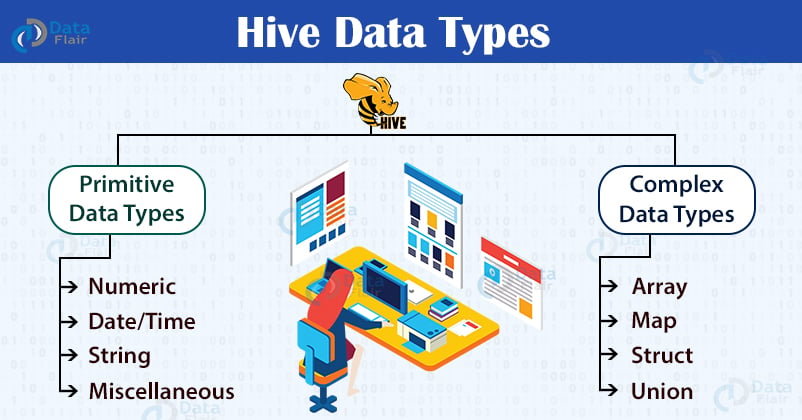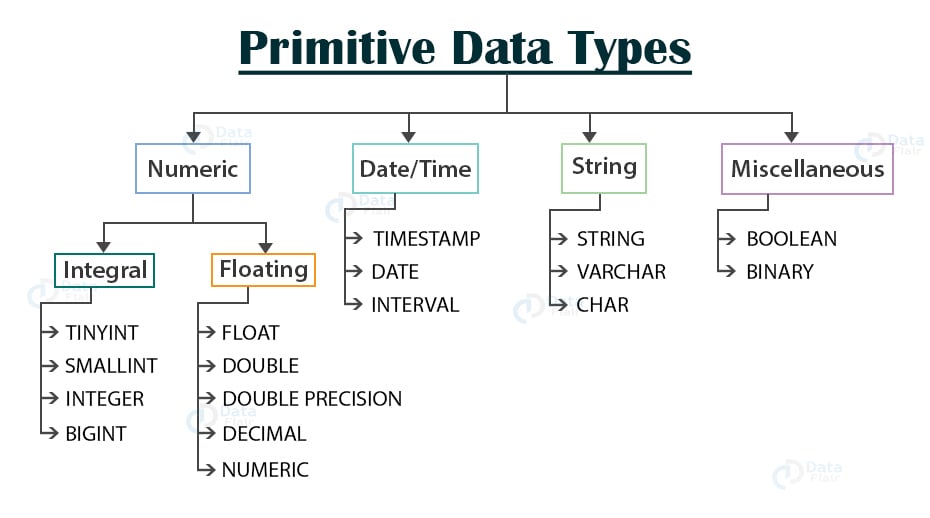Hive Data Types – Primitive and Complex Data Types in Hive
Hive Data Types are the most fundamental thing you must know before working with Hive Queries.
In our previous blog, we have discussed the Hive Architecture in detail. Now in this blog, we are going to cover Apache Hive Data Types with examples.
Data Types in Hive specifies the column type in Hive tables. The article describes the two categories of Hive Data types that are primitive data type and complex data type along with their example.
Let us now start with the Hive Data Types.
Hive Data Types
Data Types in Hive specifies the column/field type in the Hive table. It specifies the type of values that can be inserted into the specified column.
Let’s have a brief look at the Hive data types.
Primitive Type
- Numeric
- Date/time
- String
- Miscellaneous
Complex Type
- Array
- Map
- Struct
- Union
Let us first start with the Primitive Data Type.
Hive Primitive Data Type
1. [ps2id id=’Numeric’ target=”/]Numeric Type
The Numeric data type in Hive is categorized into
- Integral data type
- Floating data type
1.1 Integral data type
a. TINYINT – (1-byte signed integer ranging from -128 to 127)
b. SMALLINT – (2-byte signed integer ranging from -32, 768 to 32, 767)
c. INTEGER – (4-byte signed integer ranging from -2, 147, 483, 648 to 2, 147, 483, 647)
d. BIGINT – (8-byte signed integer ranging from -9, 223, 372, 036, 854, 775, 808 to 9, 223, 372, 036, 854, 775, 807)
In Hive, Integral literals are assumed to be INTEGER by default unless they cross the range of INTEGER values. If we want to use a low integral value like 100 to be treated as TINYINT, SMALLINT, or BIGINT, then we will use the following postfixes (shown in the below table) with the number.
| Type | Postfix | Example |
| TINYINT | Y | 100Y |
| SMALLINT | S | 100S |
| BIGINT | L | 100L |
1.2 Floating data type
a. FLOAT
It is a 4-byte single-precision floating-point number.
b. DOUBLE
It is an 8-byte double-precision floating-point number.
c. DOUBLE PRECISION
It is an alias for DOUBLE. It is only available starting with Hive 2.2.0
d. DECIMAL
It was introduced in Hive 0.11.0. It is based on Java’s BigDecimal. DECIMAL types support both scientific and non-scientific notations.
In Hive 0.11.0 and 0.12, the precision of the DECIMAL type is fixed and limited to 38 digits.
As of Hive 0.13, user can specify the scale and precision during table creation using the syntax:
DECIMAL(precision, scale)
If precision is not specified, then by default, it is equal to 10.
If the scale is not specified, then by default, it is equal to 0.
DECIMAL provides more precise values and greater range than DOUBLE.
e. NUMERIC
It started with Hive 3.0.0. The NUMERIC data type is the same as the DECIMAL type.
[ps2id id=’Date-time’ target=”/]2. Date/Time data type:
a. TIMESTAMP
Timestamps were introduced in Hive 0.8.0. It supports traditional UNIX timestamp with the optional nanosecond precision.
The supported Timestamps format is yyyy-mm-dd hh:mm:ss[.f…] in the text files.
If they are in any other format, declare them as the appropriate type and use UDF(User Defined Function) to convert them to timestamps.
The supported conversions are:
| Integer numeric type | UNIX timestamp in seconds |
| Floating-point numeric type | UNIX timestamp in seconds with decimal precision |
| Strings | java.sql.Timestamp format “YYYY-MM-DD HH:MM:SS.fffffffff” (9 decimal place precision) |
b. DATE
Dates were introduced in Hive 0.12.0. DATE value describes a particular year/month/day in the form of YYYY-MM-DD.
For example- DATE ‘2020-02-04’
It does not have a time of day component. The range of value supported for the DATE type is 0000-01-01 to 9999-12-31.
c. INTERVAL
Hive Interval data types are available only after starting with Hive version 1.2 or above.
Hive accepts the interval syntax with unit specifications. We have to specify the units along with the interval value.
For example, INTERVAL ‘1’ DAY refers to the day time.
[ps2id id=’String’ target=”/]3. String data type
a. STRING
In Hive, String literals are represented either with the single quotes(‘ ’) or with double-quotes(“ ”).
Hive uses C-style escaping.
b. VARCHAR
In Hive, VARCHAR data types are of different lengths, but we have to specify the maximum number of characters allowed in the character string.
If the string value assigned to the varchar is less than the maximum length, then the remaining space will be freed out.
Also, if the string value assigned is more than the maximum length, then the string is silently truncated.
The length of the varchar is between(1 to 65535).
Trailing whitespace is important in varchar and will affect the comparison results.
c. CHAR
CHAR data types are fixed-length.
The values shorter than the specified length are padded with the spaces.
Unlike VARCHAR, trailing spaces are not significant in CHAR types during comparisons.
The maximum length of CHAR is fixed at 255.
[ps2id id=’Miscellaneous’ target=”/]4. Miscellaneous data type
a. BOOLEAN
Boolean types in Hive store either true or false.
b. BINARY
BINARY type in Hive is an array of bytes.
This is all about Hive Primitive Data Types. Let us now study Hive Complex Data Types.
Hive Complex Data Type
Complex Data Types are built on the top of Primitive Data Type.
The Hive Complex Data Type are categorized as:
[ps2id id=’Array’ target=”/]1. arrays
Array in Hive is an ordered sequence of similar type elements that are indexable using the zero-based integers.
Arrays in Hive are similar to the arrays in JAVA.
array<datatype>
Example: array(‘Data’,’Flair’). The second element is accessed as array[1].
[ps2id id=’Map’ target=”/]2. maps
Map in Hive is a collection of key-value pairs, where the fields are accessed using array notations of keys (e.g., [‘key’]).
map<primitive_type, data_type>
Example: ‘first’ -> ‘John’, ‘last’ -> ‘Deo’, represented as map(‘first’, ‘John’, ‘last’, ‘Deo’). Now ‘John’ can be accessed with map[‘first’].
[ps2id id=’Struct’ target=”/]3. structs
STRUCT in Hive is similar to the STRUCT in C language. It is a record type that encapsulates a set of named fields, which can be any primitive data type.
We can access the elements in STRUCT type using DOT (.) notation.
STRUCT <col_name : data_type [ COMMENT col_comment], ...>
Example: For a column c3 of type STRUCT {c1 INTEGER; c2 INTEGER}, the c1 field is accessed by the expression c3.c1.
[ps2id id=’Union’ target=”/]4. union
UNION type in Hive is similar to the UNION in C. UNION types at any point of time can hold exactly one data type from its specified data types.
The full support for UNIONTYPE data type in Hive is still incomplete.
UNIONTYPE<data_type, data_type, ...>
Handling of NULL Values
In Hive data types, the missing values are represented by the special value NULL.
So, this was all in Hive Data Types. Hope you like our explanation.
Summary
In short, we can summarize the article by saying that the Hive Data types specify the column type in the Hive table.
I hope after reading this article, you have understood the data types in Hive and also its major classification of Primitive and Complex data types.
Now its time to install Apache Hive in 5 min and start working on Hive.
In the next section, we will discuss the Hive Operators in detail.
Keep Learning!!
Your 15 seconds will encourage us to work even harder
Please share your happy experience on Google




